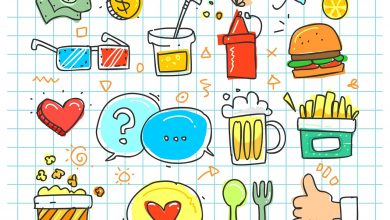
How to Make Healthier Fast Food Choices
According to a 2018 estimate by the Centers for Disease Control and Prevention, more than 85 million Americans eat fast food meals on any given day. In a study by the Harvard Medical School/Harvard Pilgrim Health Care Institute, it was found that adults ordering fast food meals consumed an average of 836 calories per meal and teenagers consumed an average of 756 calories per meal.
Ideally, a person can consume up to 2000 calories in an entire day, provided it has the right amount of carbs, proteins, and saturated fats. For example, in a day, a person can consume between 44 grams and 77 grams of fat. However, this fat refers to the good fat – saturated fat. Fast food, on the other hand, contains a lot of trans-fat, which is bad fat. While it’s true that some fast food meals contain only between 16 and 20 grams of trans fat, over the course of a few weeks, this trans-fat adds-up, and it can increase your LDL cholesterol (the bad cholesterol) and put you at risk of coronary artery disease.
One way to ensure you’re not at risk of consuming a lot of trans-fat is to be mindful of how many calories you’re consuming and what nutrients food have (or lack). But this is where the problem arises.
According to lead researcher Dr. Jason Block, the people surveyed in the Harvard study had a tendency to underestimate how many calories they ate in a single fast food meal – teenagers by 34 percent, parents of school going kids by 23 percent, and other adults by 20 percent.
“These findings tell us that many people who eat at fast-food restaurants may not be making informed choices because they don’t know how many calories they’re consuming,” Block says.
But how do you get this nutritional information? In the same study, it was found that most fast food chains surveyed did not provide nutritional information on their menu boards.
So what do you do when you don’t get access to important nutritional information? How can you make healthy choices when you’re forced to live on fast food, because of the nature of your job/life?
Healthy Tips to Follow When Eating Fast Food On a Regular Basis
The good thing is certain lifestyle changes can help you eat healthy, even when the food isn’t exactly nutritious. Here, we give you a few easy-to-follow tips and tricks, which you can implement the next time you order at a fast food joint:

Choose fast food chains that offer healthier options
Right off-the-bat, if you can find one, visit a fast food joint that offers healthy snacking options like salads, fruit platters, and soups. This prevents your having to worry too much about all the grease that you might otherwise end up eating. You can even substitute a side with a salad or fruit platter, instantly making your meal healthier.
These days, all big fast food brands are creating menus that are lower in trans-fat and higher in organic ingredients.
Study up about the nutrition offered by fast food dishes
According to the Patient Protection and Affordable Care Act of 2010 (Affordable Care Act), for any restaurant in the US that forms part of a chain that has more than 20 outlets, it is mandatory for them to provide nutritional labels about their dishes. However, the reality is that most chain restaurants still don’t do this.
But there is a way to find out how many calories on average are present in a fast food meal. For example, Calorie King is a calorie-counting website that provides a breakdown of dishes made at famous restaurants located in the USA, the UK, and Australia. All you need to do is type in the restaurant’s name, select the dish you want to learn about, and you’ll get a breakdown of the calories it possesses.
Plan what to order in advance
Assuming you use the above tool, you’ll now have the information to create a healthier fast food meal plan. So, plan ahead about what you’ll order and avoid the temptation to deviate from your meal plan.
Take into consideration any subsequent visits you may make to a fast food joint during the rest of the day. This way you can eat lesser or choose healthier options to make up for any high-calorie items you may choose later.
Stick to regular – don’t supersize
Supersize has become the norm these days, and there’s nothing as detrimental to your health than a supersized meal.
Take McDonald’s fries for example. While the large pack costs $1.70, the supersize costs $1.95. You might think you’re making a smart investment by buying the supersize – after all, it’s extra fries for a mere 25 cents. You can always keep some of the fries for later.
But let’s be honest. How many of us have the willpower to resist temptation?
You see, while the large fries boast of 540 calories and 26 grams of fat, the supersize fries contain a whopping 610 calories and 29 grams of fat. Ideally, a single meal should be 500 calories – but this is just one side dish, and it’s already over your allocated calorie-budget. You still have to order the main entree and the drink.
The best course of action here is to skip the supersize. We know that McDonald’s has agreed to get rid of the supersize to help customers make healthier choices, but lots of other restaurants still have these options.
When ordering, choose smaller fries/drinks, single patties, thinner crusts, and smaller bowls.
Skip the beverage a few times each week
Does your favorite shake contain whole milk, whipped cream and ice cream? Well, you may be consuming as many as 1000 calories and 80 grams of fat each time you gulp down a glass. The case is the same with sodas, with calories ranging from 150 to 300. Added to the rest of your meal, your beverages can really skyrocket the number of calories you consume.
Assuming you have a beverage with each meal, you’re in for serious trouble. It’s been found that regular consumption of fatty milkshakes and sodas can clog up your blood vessels, change the shape of your RBCs, and lead to the onset of cardiovascular disease.
To stay healthy while eating fast food, consider skipping the beverage at every alternate meal. If you can, stave-off beverages completely. Stick to plain water.
In fact, do one better and skip the sides as well. Have just one meal – the main meal, sans the side and the beverage. This will do a lot of wonders to your health. If this is too difficult, consider having a side of baked potato instead of fries or bacon. You can also include a yogurt parfait instead of the side – it fulfills your sweet cravings, while still being healthy.

Choose dishes that are lower in fat and higher in fiber and protein
High protein and high fiber options have started appearing on fast food menus these days. These items skip the mayo and the egg yolk and instead use wholesome grain-filled bread and organic veggies.
Take the Starbucks Reduced-Fat Turkey Bacon & Cage Free Egg White Breakfast Sandwich for example. It’s only 210 calories and has just 5 grams of fat, but also contains 18 grams of protein, 3 grams of fiber, and 26 grams of healthy carbs.
The Chipotle Steak Salad with lettuce, fajita vegetables, and roasted chili-corn salsa is another great example – it boasts of 255 calories, just 7.5 grams of fat, 25 grams of protein, 23 grams of carbs, and 6 grams of fiber.
Don’t buy the toppings, bring them with you
The truth is, a lot of calories in fast food dishes come from the toppings. Everything from bacon bits to glazed pear will add more fat and more calories to your meal.
A great way to limit the negative impacts of toppings is to hand-pick healthy toppings like dried nuts, flax seeds, yogurt, carrot sticks, etc. at home and carry them with you to the restaurant. Order a plain, toppings-free meal, take it back to your table, and garnish it as you like with healthy and wholesome toppings.
Limit sodium-high foods to a few times each week
Did you know that fast food in the US is saltier than fast food in other countries? In fact, Americans eat around 3,400 mg of salt per day. The medically recommended limit is 2,300 mg.
Take Quizno’s Large French Dip Sub – with the salted and fried meat, mozzarella, roasted and spiced veggies, and the various sauces and dips, you consume a staggering 3,610 mg of salt in just one meal.
Salt has terrible consequences of health and can lead to stroke, heart attack, kidney failure, and dementia. So choose items which are low in salt. Salads and fruit platters are great. You should also avoid dressing your meals, as these ingredients contain a lot of salt.
Choose roasted, baked, and grilled when available
Fried meat and veggies can increase the grease you consume and clog up your arteries. If you have the option of having the meat and veggies roasted, baked, or grilled, go ahead.
Even with roasted, baked and grilled, ask the staff to use as little oil/butter during the process.
Learn about the nutritional value of sauces, dressing, and condiments before you order them
Just as with the toppings, the sauces, dressing, and condiments you use on your fast food meal determine how healthy or unhealthy the meal will be.
For example, barbeque sauce has 23 calories per tablespoon, cream sauce a whopping 439 calories, ketchup 15 calories, sour cream 26 calories, and vinaigrette 18 calories. Even light mayo has 45 calories. (You can learn more about sauce/dressing/condiment calories here).
Most of us like to have two to three sauces on our food, maybe more. Just imagine how many additional calories we’ll be consuming in a single meal then.
So when choosing the sauces, check the nutritional content of the ingredients before asking for them. You should also consider saying no to sliced and liquid cheese that may be offered as a topping/dressing for your meal.

Alternate between meat and vegan or vegetarian options
A lot of fast food meals use red meat – pork, beef, lamb, venison, etc. Red meat has been linked with cardiovascular disease, kidney problems, and cancer. A healthy alternative to red meat is white meat like fish and chicken, but only if they’re not fried.
Another great way to order healthy at fast food joints is to go the vegetarian or vegan way. The ingredients used in these meals are organic, healthy, and light on the stomach. Plus, a lot of the greens used in these meals are full of antioxidants and essential nutrients, which are hard to come by in fast food.
Consider choosing from the kids’ menu
Kids’ menus are, by design, more healthy because they contain fewer calories (about 250 – 300 calories), come with smaller portion sizes, and have less cheese and fewer sauces. They make the ideal meal for someone who’s just beginning to experiment with healthy fast food orders.
Avoid rice and wheat-based items
Fast food goes beyond burgers and sandwiches. You have Mexican food, which is full of carb-high ingredients like tortillas and rice. Italian food contains pasta and pizza crust, and Chinese take-away features noodles. Most of these foods are made from rice or wheat – both of which are bad on the heart and the gut.
While you don’t have to swear-off pasta, pizza, and noodles completely, you can choose healthier versions of these items. For example, zucchini/squash noodles, sweet potato pizza crust, quinoa/millet pasta, black bean pasta, Shirataki noodles, quinoa pizza crust, and beets/eggplant pizza crust are all trending options in fast food restaurants. With Mexican, you can go with soft-shell tortillas (not fried and hence healthier) and choose couscous, barley, quinoa, and Shirataki rice for the burrito/bowls.
Even with garlic bread, you should choose sprouted whole grain bread, sourdough, flaxseed bread, or millet bread. They’re far healthier than other types of bread.
Eat only half the meal at a time
Ideally, the best way to eat healthy at a fast food joint is to walk away from the plate when you still have some food left. But regularly wasting food isn’t a good habit. Instead, consider eating only half of your sandwich/pizza/bowl and having the rest packed for take-away. You can eat the rest during the next meal.
This is a type of portion control, and while this is hard to do initially, it can really help reduce the number of calories you consume overall in a single day.
Use utensils that you don’t know how to use when eating
Have you ever noticed how difficult it is to eat a full meal when you don’t know how to eat it? For example, if you don’t know how to use chopsticks, you’re more likely to eat less because you don’t know how to eat with them. So you’ll tend to eat slower, which gives your brain more time to understand its hunger/full signals.
Fast food tends to be eaten fast and the brain doesn’t get enough time to decipher your hunger/full cues. Using such food-specific utensils whenever you can, can help consciously avoid overeating by eating slower.



